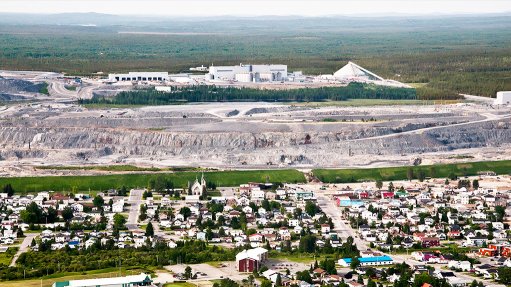
Name: Canadian Malartic mine.
Location: The Canadian Malartic mine is located in the heart of the prolific Abitibi goldbelt, in Quebec, south of the town of Malartic, in Canada.
Controlling Company: The mine is a partnership between Agnico Eagle Mines (50%) and Yamana Gold Corporation (50%).
Brief History: The Canadian Malartic mine took six years – from the start of exploration drilling in 2005 by the then-owner Osisko Mining Corporation – to complete mine development. Osisko received government approval in August 2009 to begin construction of the mine. The first gold pour occured in April 2011, and the start of commercial production in May 2011. Osisko Mining was jointly acquired by Agnico Eagle and Yamana in June 2014.
Brief Description: The Canadian Malartic operation is one of the largest operating gold mines in Canada. The mine comprises a large openpit and processing plant. The operation has an estimated life-of-mine of 17 years.
Geology/Mineralisation:
The Canadian Malartic deposit is an Archean porphyry gold system, consisting of a widespread shell of disseminated gold-bearing pyrite mineralisation, hosted by diorite porphyry and altered Pontiac group metasediments. Drilling and compilation work has outlined a gold mineralised system measuring 1.9 km by 350 m, with a variable true thickness ranging from 40 m to 270 m to a vertical depth of 410 m from surface. The system is open to the west and to the south at depth.
Mineralisation in the CM Extension is largely along the southern edge of the Cadillac fault zone. The disseminated to stockwork gold mineralisation is hosted in potassic-altered, silicified greywackes (south of the fault) and in altered porphyry and gabbro dykes and ultramafic rocks in the fault zone.
The Canadian Malartic and CM Extension – a separate but contiguous deposit within the Cadillac-Larder Lake fault zone – deposits contain the bulk of the current reserves and are part of one large pit. The Western Porphyry deposit, a few hundred metres north-west of the pit, contains mineral resources.
Products: Gold.
Reserves: Total proven and probable reserves as at December 31, 2014, were estimated at 126.95-million tonnes grading 1.06 g/t of gold.
Resources: Total measured and indicated resources as at December 31, 2014, were estimated at 35.55-million tonnes grading 0.85 g/t of gold. Inferred resources were estimated at 22.66-million tonnes grading 0.76 g/t of gold.
Mining Method: Conventional openpit.
Major Infrastructure and Equipment: Access to the Canadian Malartic pit is by a 35-m-wide, 8% to 10% decline ramp, which can accommodate the haul trucks. Loading of waste and ore is currently undertaken by three CAT 6060 28 m3 electric-driven hydraulic shovels and one CAT 6050 26 m3 backhoe, complemented by two L-1850 LeTourneau wheel loaders and a CAT 994 wheel loader, and transported by CAT 793F 217 t class rigid trucks.
Ore is processed at the 55 000 t/d capacity Canadian Malartic mineral processing complex, based on 92% plant availability. Run-of-mine ore is transported to a crushing circuit comprising a gyratory crusher that feeds two cone crushers. The crushed ore is stockpiled in a covered pile, then conveyed to the semiautogenous (SAG) grinding circuit, followed by three identical ball mills, each in closed circuit with hydrocyclones. Two pebble crushers handle the oversize material from the SAG mill. The slurry is thickened to about 50% solids before being fed to the leach-tank circuit for conventional cyanidation, followed by carbon-in-pulp processing technology.
To reduce the environmental impact, tailings are detoxified and thickened prior to being pumped to a tailings impoundment facility. Tailings thickening reduces the required size and footprint of the tailings impoundment and recycles more of the water back to the plant for re-use. The tailings are treated to reduce cyanide levels before they are discharged into containment cells in the former East Malartic tailings and sedimentation pond areas.
Prospects: In March, the partnership acquired an additional 30% interest in Malartic CHL property from Abitibi Royalties. The partnership now owns a 100% interest in the Malartic CHL property.
The Malartic CHL property adjoins the Canadian Malartic mine to the east and hosts in part the Odyssey North discovery, the Jeffrey gold deposit and the eastern nose of the Barnat gold deposit.
Drilling has resumed on the Odyssey North and South zones and, to date, two holes have been drilled. Data from these two holes is being compiled and interpreted. Drilling is planned on the Odyssey zones, with a proposed budget of $3-million.
Contact: Corporate communications.
Contact Details:
Agnico Eagle,
tel +1 416 847 8669,
fax +1 416 367 4681,
email media@agnicoeagle.com, and
website http://www.agnicoeagle.com.